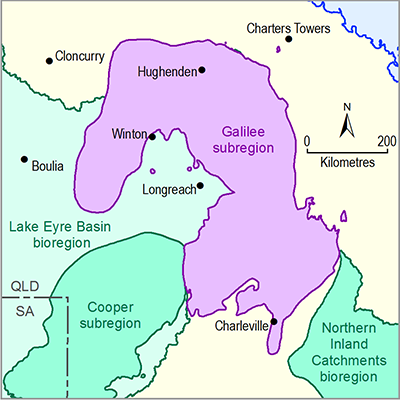Summary
The Galilee subregion is located entirely in Queensland, and includes the headwaters of seven major river basins. The subregion spans an area of about 248,000 km2, extending from the headwaters of easterly flowing rivers across the eastern highlands and well into the Australian Central Lowlands physiographic province. Elevations vary from a minimum of about 150 m Australian Height Datum (mAHD) in the Diamantina River floodplain near the north-western margin of the Galilee subregion to nearly 1000 mAHD at the north-western end of the Carnarvon Ranges in the south-eastern portion of the subregion. In addition to major river systems, an arcuate intermontane valley in the eastern highlands contains two large playa lakes, Buchanan (117 km2) and Galilee (257 km2), within closed internal drainage basins. Both of these lakes are listed in A directory of important wetlands in Australia (Department of the Environment, 2014).
Soils vary across the subregion and typically correlate with physiographic region and land cover or vegetation. The eastern highlands portion of the subregion are topographically and physiographically more complex than the lowlands and have a correspondingly greater complexity of land cover and soil types. Kandosols, which are non-calcareous and low texture-contrast soils with moderate fertility and agricultural potential, are the dominant soil in the eastern highlands portion of the subregion. Also occurring are Vertosols, Tenosols, Sodosols and Rudosols as well as Ferrosols in the north, on the Gilberton and Burdekin plateaux, and Chromosols and Calcarosols in the south-east, on the Nagoa Scarplands and the Maranoa Lowland. Clay-rich Vertosols with shrink-swell features and high agricultural potential dominate much of the grassland lowlands in the central portion of the subregion west of the eastern highlands. The western lowland margins of the subregion have a more complex topographically controlled mixture of Vertosols, Sodosols, Tenosols, Rudosols, Kandosols and Dermosols which form on variable parent materials and have generally low to moderate fertility and agricultural potential.
Though significant areas have soils with moderate to high fertility and agricultural potential, there has been virtually no agricultural development in the form of cropping or pasture improvement. Sheep and cattle grazing on natural pasture is the dominant land use in the subregion. Other than relatively small areas of plantation forestry and minor clearing for pasture improvement, there is very little modification of the natural land cover, which is dominated by hummock and tussock grasses in the lowland west and sparse and scattered trees in the eastern highlands.
The subregion covers 13 local government areas, with none entirely included, and spans parts of nine planning regions and five natural resource management regions. The population is sparse and difficult to estimate accurately, as census divisions do not correspond to the subregion boundary. In the 2011 census there were almost certainly less than 20,000 residents in the subregion, representing a considerable decline (5 to 10%) over the previous decade. Charleville is the largest town in the subregion with a population of 3561 people. Primary production, mainly in the form of rangeland grazing, is the major economic activity of the subregion and accounted for 32.5% of occupations in the 2011 census. This is followed by government services (19.8%), and retail, construction, education, transport and accommodation (all 5 to 8%). The development of proposed mining and coal seam gas extraction in the subregion may affect population and economic activities in the future.
The climate is generally hot and dry throughout, becoming more extreme towards the west where the altitude is lower and the coast more distant. Rainfall variation across the region ranges from less than 300 mm to more than 700 mm. Rainfall is summer dominant and potential evapotranspiration significantly exceeds rainfall in all months. Climate change projections suggest slightly higher warming for the Galilee subregion than the continental average, with a range of 1.0 to 1.2 °C by 2030 and up to 3 to 4 °C by 2070 under a high greenhouse gas emissions scenario. With high emissions, there is a greater than 90% probability of exceeding 2 °C warming and a 20 to 40% probability of exceeding 4 °C warming by 2070. Projected changes in rainfall have more uncertainty but a slight decline of 1 to 2.5% is projected by 2030 and this increases to 5 to 20% by 2070 under a high-emissions scenario. Most of these rainfall declines are projected to occur in winter and spring.

